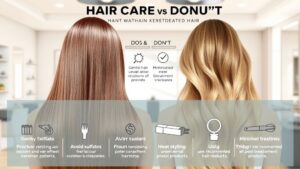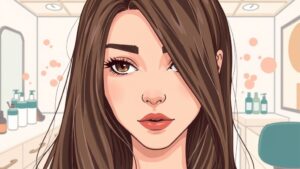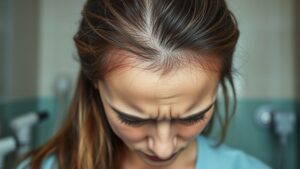Keratin treatments have become a popular solution for frizzy, unmanageable hair. They promise sleek, shiny strands that are easier to style. However, many individuals experience an unexpected downside: hair fall after keratin treatment.
While it’s often temporary, for some, it can be distressing and persistent. If you’re facing this issue, natural home remedies can help restore your hair’s health without adding more chemical burden.
🔍 Why Does Hair Fall After Keratin Treatment?
Keratin treatments involve applying a chemical formula to the hair, then sealing it with heat. The process is designed to smooth and straighten the hair shaft, but the intense heat (often 450°F) and chemical exposure can weaken hair over time.
Key reasons for hair fall post-keratin:
Chemical overload: Formaldehyde or its derivatives damage hair roots.
Heat damage: High-temperature flat irons weaken the hair shaft.
Product buildup: Residues from keratin formulas clog follicles.
Scalp sensitivity: Irritation or allergic reactions affect root health.
Poor aftercare: Sulfate shampoos, tight hairstyles, and improper washing routines lead to breakage.
💡 Important Note: Hair fall often begins 1 to 3 weeks after a keratin treatment, as the hair adjusts to the chemical process and weakened strands start to shed. If it persists for more than a month, you should consult a dermatologist.
🍯 Natural Home Remedies to Stop Hair Fall After Keratin
The best approach is gentle, nourishing, and non-chemical. Here are powerful remedies you can make at home:
🌿 Aloe Vera Gel Scalp Treatment
Why it works: Aloe vera is cooling, anti-inflammatory, and rich in proteolytic enzymes that repair dead skin cells.
How to use:
Scoop out fresh aloe vera gel.
Apply directly to the scalp.
Leave on for 30–45 minutes.
Rinse with cool water.
📅 Frequency: 2–3 times per week.
🥚 1.2 Egg Yolk Hair Mask
Why it works: Eggs are high in biotin and protein, which help rebuild hair strands.
How to use:
Beat 1 egg yolk with 1 tbsp olive oil and 1 tbsp honey.
Apply to hair and scalp.
Cover with a shower cap.
Wash after 30 minutes with cold water.
📅 Frequency: Once a week.
⚠️ Tip: Always use cold water to prevent the egg from “cooking.”
🧄 1.3 Garlic Infused Coconut Oil
Why it works: Garlic has sulfur and selenium that fortify the hair shaft.
How to use:
Crush 2 garlic cloves and mix with 3 tbsp coconut oil.
Heat gently (not boiling).
Cool and strain.
Massage into the scalp for 10 minutes.
Leave overnight.
📅 Frequency: Twice a week.
🌰 1.4 Castor Oil and Almond Oil Blend
Why it works: Castor oil is rich in ricinoleic acid, which stimulates blood flow to hair follicles. Almond oil adds vitamin E for extra nourishment.
How to use:
Mix 2 tbsp castor oil and 2 tbsp almond oil.
Warm slightly and massage onto the scalp.
Wrap your hair in a warm towel for 20 minutes to boost absorption of nourishing treatments and improve scalp circulation naturally.
Wash off with mild shampoo.
📅 Frequency: 2 times per week.
🍋 1.5 Fenugreek (Methi) Paste
Fenugreek works wonders for post-keratin hair because its lecithin-rich content deeply nourishes the scalp, fortifies weakened follicles, and restores lost moisture for healthier, fuller strands.
How to use:
Soak 2 tbsp of fenugreek seeds overnight.
Grind into a fine paste.
Apply to scalp and roots.
Leave for 30 minutes.
Wash off with lukewarm water.
📅 Frequency: Weekly.
🍌 1.6 Banana and Yogurt Protein Pack
Why it works: Bananas hydrate and repair damaged strands; yogurt is packed with lactic acid and protein.
How to use:
Combine one ripe banana with two tablespoons of yogurt and a teaspoon of honey to create a nourishing hair mask that deeply hydrates and strengthens your strands.
Apply from the scalp to tips.
Leave on for 30–40 minutes.
Rinse thoroughly.
📅 Frequency: Once every 7–10 days.
🧅 1.7 Onion Juice
Why it works: Onion juice boosts collagen production and is clinically shown to support regrowth.
How to use:
Extract juice from 1–2 onions.
Apply with cotton to the scalp only.
Leave for 30 minutes.
Wash with mild, fragrance-free shampoo.
📅 Frequency: Twice a week.
⚠️ Warning: Patch test for allergies.
🧖♀️ Hair Care Do’s and Don’ts After Keratin Treatment
Once you’ve treated hair fall naturally, long-term results depend on daily habits.
✅ Do’s:
Use sulfate-free, paraben-free shampoos.
Let your hair air-dry instead of blow-drying.
Sleep on satin or silk pillowcases.
Trim split ends every 6–8 weeks.
Eat protein-rich foods (eggs, fish, lentils).
❌ Don’ts:
Don’t wash hair daily; 2–3 times a week is ideal.
Steer clear of tight hairstyles like ponytails or buns that strain your roots and contribute to breakage
Don’t use hot tools more than once a week.
Never skip conditioner; post-keratin hair dries quickly.
Don’t color hair too soon after keratin.

🥗 Diet & Lifestyle Changes to Prevent Hair Fall
Hair health begins on the inside. After a keratin treatment, your body may be trying to recover from stress and chemical exposure.
Nutrients That Support Hair Growth:
Biotin: eggs, almonds, spinach
Omega-3 fatty acids: flaxseeds, fish
Vitamin D: sunlight, mushrooms, fortified milk
Iron: lentils, leafy greens, red meat
Zinc: pumpkin seeds, chickpeas
🫀 Stay hydrated: Drink 8–10 glasses of water daily.
🧘♀️ Reduce stress: Yoga, meditation, and adequate sleep can drastically reduce hormonal hair loss.
🌼 Herbal Rinses That Strengthen Hair Roots
Try these rinses once a week to improve scalp circulation:
🌿 Neem Water Rinse:
Boil neem leaves in water.
Cool and use as the last rinse post-shampoo.
🌸 Hibiscus Flower Water:
Boil hibiscus petals in water.
Rinse after conditioning to add shine and strength.
🌾 Green Tea Rinse:
Brew strong green tea.
Cool and pour on scalp to reduce DHT, the hormone linked to hair loss.
🧴 Homemade Scalp Serums
Try this nightly serum recipe to enhance regrowth:
DIY Rosemary + Peppermint Serum:
3 tbsp jojoba oil
10 drops of rosemary oil
5 drops peppermint oil
Store in a dropper bottle.
Apply a few drops to the scalp at bedtime.
🕰️ Leave overnight, wash off in the morning.

⚠️ When to See a Doctor?
Home remedies help in mild to moderate cases. If hair fall is:
More than 100 strands/day
Accompanied by scalp redness or pain
Lasts longer than 8 weeks post-treatment
Appears in patches (alopecia)
➡️ Consult a dermatologist or trichologist immediately.
Keratin treatments are a double-edged sword. While they provide instant gloss and smoothness, they can also leave your hair vulnerable. By focusing on natural remedies, proper hair care, and nutritional support, you can combat post-keratin hair fall effectively.
Remember, the goal isn’t just to stop hair fall, but to regrow stronger, healthier hair naturally. With consistency and patience, you’ll start noticing visible results in 4–6 weeks.
Why Does Hair Fall Out After Keratin Treatment?
Keratin treatments promise sleek, shiny, and frizz-free hair, often making them irresistible to those with unruly curls or frizz-prone locks. But many individuals experience a scary side effect: increased hair fall. This can be especially frustrating after investing time and money into what’s supposed to be a beautifying treatment.

💬 What Is a Keratin Treatment?
Keratin, a structural protein naturally present in your hair, skin, and nails, acts like a protective shield that keeps them strong, smooth, and resilient. In keratin hair treatments, a synthetic or plant-derived form of keratin is applied to the hair, then sealed in with heat.
This process helps:
Smoothen frizz
Add shine
Temporarily straighten curls
Make styling easier
There are multiple types, including
Brazilian Blowout
Cysteine Treatment
Keratin Complex Smoothing Therapy
Most use formaldehyde or formaldehyde-releasing chemicals, which can be harsh on both the scalp and strands.
🔬 How Keratin Treatments Work on Hair
Keratin treatments alter the hair structure using:
Chemical formulas – these break down disulfide bonds.
Flat-ironing at 450°F (230°C) seals the product into the cuticle.
This duo softens and flattens curls, but it also forces your hair to undergo high-stress processing.
🧨 Why Hair Falls Happens After Keratin
Let’s get to the core question: why is your hair falling out?
Here are the primary reasons:
🔥 1. Heat Damage
The intense heat from flat ironing during keratin treatments can strip the hair cuticle and compromise root strength, leading to increased breakage and hair fall. Over time, this leads to hair fall and thinning.
🧪 2. Chemical Sensitivity or Reaction
Many keratin products contain formaldehyde or aldehyde-based compounds. These chemicals can:
Irritate the scalp
Disrupt follicular health
Causes inflammation and hair shedding

❌ 3. Wrong Product Usage
Using keratin not suitable for your hair type can backfire, especially on fine or bleached hair. Some stylists also leave the product in too long or use excessive heat.
🧴 4. Buildup on the Scalp
Keratin coatings form a film on the hair and scalp. Over time, this can clog pores, choke hair follicles, and disrupt the natural hair growth cycle.
😬 5. Poor Aftercare
Post-treatment, using sulfate shampoos, tight hairstyles, or frequent blow-drying can increase breakage and fall-out.
🧬 6. Pre-existing Hair Conditions
If you already have issues like dandruff, alopecia, or hormonal imbalances, keratin can make things worse.
🔍 Major Causes: A Closer Look
Let’s break these causes down further:
| Cause | How It Affects Hair |
| Heat styling (450°F) | Weakens the cortex, leading to shaft breakage |
| Formaldehyde | Inflammation of follicles, toxic buildup |
| Blocked follicles | Disrupts oxygen supply to hair roots |
| Over-processing | Repeated treatments = cumulative damage |
| Allergic reactions | Can cause red patches, itching, and fall-out |
⚠️ Who’s at Higher Risk of Post-Keratin Hair Fall?
Not everyone will experience extreme shedding. However, you’re at higher risk if you:
Have thin or chemically treated hair
Have scalp issues like seborrheic dermatitis
Use keratin treatments too often (more than 2x per year)
Use a flat iron daily after treatment
Have nutritional deficiencies (iron, biotin, vitamin D)
🚨 Early Warning Signs of Damage
Here’s how to catch the problem early:
Hair feels weaker or gummy when wet
Clumps of hair in the shower or brush
Itchy, red, or flaky scalp
Noticeable hairline thinning
Increased breakage at the crown or nape
🌿 Home Remedies to Reduce Hair Fall After Keratin
✅ 1. Aloe Vera + Castor Oil Mask
Blend 2 tablespoons of fresh aloe vera gel with 1 tablespoon of castor oil to create a nourishing hair mask that promotes strength and shine.
Apply to scalp, leave for 30 mins
Rinse with lukewarm water
✅ 2. Onion Juice Scalp Therapy
Rich in sulfur, it promotes regrowth
Mix 2 tablespoons of onion juice with 1 teaspoon of olive oil and gently massage it into your scalp to boost circulation and nourish hair roots naturally.
Leave for 20 minutes, rinse with sulfate-free shampoo
✅ 3. Fenugreek Seed Paste
Soak 2 tablespoons of seeds overnight, then blend them into a smooth paste for a powerful, nutrient-rich hair treatment.
Apply to the scalp for 30 minutes
Improves blood flow and follicle health
✅ 4. Green Tea Rinse
Anti-inflammatory + DHT blocker
Steep two green tea bags in a cup of hot water to create a soothing, antioxidant-rich infusion for your scalp and hair.
Cool and pour onto the scalp after shampoo

🧴 Hair Care Tips to Prevent Further Damage
🧼 Shampoo:
Always choose sulfate-free and paraben-free formulas
Wash hair only 2–3 times a week
🧖♀️ Conditioning:
Use a deep conditioner with keratin-safe ingredients weekly
🧴 Oil Massage:
Use light oils like almond or jojoba twice weekly
💨 Drying:
Air-dry only
Avoid towel rubbing; use microfiber towels
💇♀️ Styling:
No heat for 3–4 weeks post-treatment
Loose hairstyles only
🥦 Nutrition for Stronger Hair
Hair fall often reflects internal imbalances.
Must-Have Nutrients:
| Nutrient | Food Sources |
| Biotin | Eggs, almonds, sweet potatoes |
| Iron | Spinach, lentils, red meat |
| Zinc | Pumpkin seeds, chickpeas |
| Vitamin D | Sunlight, mushrooms, fortified milk |
| Protein | Greek yogurt, fish, legumes |
💧 Hydrate: Drink at least 2–3 liters of water daily.
👩⚕️ When to Seek Medical Help
Home care isn’t always enough. See a dermatologist if
Hair fall continues beyond 6–8 weeks
There’s visible scalp thinning or bald patches
You have redness, burning, or scabbing
You notice sudden shedding in clumps
They may recommend:
Minoxidil
PRP therapy
Microneedling
Blood tests for thyroid or hormonal imbalances
✔️ Do’s and Don’ts After Keratin
✅ Do:
Use silk pillowcases to reduce friction
Follow a regular oiling routine
Get trims every 2 months
Use wide-tooth combs
Switch to low-heat blow drying (cool mode)
❌ Don’t:
Use keratin treatments more than 2x a year
Apply heat styling tools frequently
Tie tight ponytails or buns
Skip conditioner
Ignore early signs of shedding
🔄 Alternatives to Keratin Treatments
Want smooth hair without the risk? Try:
Cysteine hair therapy (formaldehyde-free)
Hair Botox (deep conditioning, not actual Botox)
Silicone-free smoothing masks
Ayurvedic smoothing oils (like bringaraj or amla-infused)
📌 Final Thoughts
Keratin treatments can deliver smooth, salon-worthy results, but they come at a cost. Hair fall is a real and common side effect, especially if your hair is already fragile or poorly maintained.
The key is awareness. By understanding the underlying causes, avoiding harsh aftercare, and supporting your scalp with gentle home remedies and nutrition, you can stop the damage and stimulate regrowth.
Hair health is not about quick fixes — it’s about long-term care, clean habits, and treating your scalp like skin.
🙋♀️ Frequently Asked Questions (FAQs)
1. Is hair fall after keratin treatment normal?
Yes, mild hair fall is common due to chemical and heat exposure. Excessive shedding, however, signals damage or a reaction.
2. How long does post-keratin hair fall last?
It typically lasts 2–6 weeks. With proper care and nutrition, hair growth can return to normal in 3–4 months.
3. Can I do another keratin treatment to fix the damage?
No. Repeating the treatment too soon can worsen hair loss. You need to focus on healing and recovery first.
4. How long does hair fall last after a keratin treatment?
Hair fall can last anywhere from 2–6 weeks, depending on your hair’s condition, aftercare, and overall health.
5. Is hair fall after keratin treatment normal?
Mild shedding is normal due to chemical exposure and heat damage. Excessive hair fall indicates poor scalp health or product misuse.

